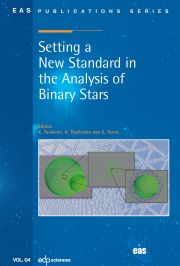Article contents
UV-irradiated hydrogenated amorphous carbons (HACs) as carriersof the interstellar UV bump
Published online by Cambridge University Press: 13 February 2013
Abstract
Hydrogenated amorphous carbons (HACs) are considered as laboratory analogues to cosmiccarbonaceous nanoparticles in the interstellar medium (ISM). The optical properties ofnano-sized HACs may be influenced by the UV processing. The variation of the internalstructure leads to dramatic changes in the spectral properties in the FUV-VIS range. Thisscenario can explain some astronomical features such as the interstellar UV bump at 4.6μm-1. The spectrum of HACs, irradiated by a dose of UVirradiation that corresponds to 21–33% of the average dose of the UV radiation in diffuseISM, exhibits a new band centered at 4.6 μm-1. This resultconfirms, for the first time, the suggestion by Mennella et al. (1996)that irradiated HACs might be considered as the carriers of the interstellar UV bump at4.6 μm-1. However, the amount of carbon needed to reproducethis band is higher than that available for interstellar carbon dust grains. So the idealstructure of irradiated HACs that would produce a band of sufficient strength has still tobe searched for.
Information
- Type
- Research Article
- Information
- Copyright
- © The Author(s) 2013
References
Références
- 1
- Cited by

